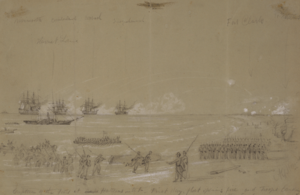
USS Minnesota was a wooden steam frigate in the United States Navy. Launched in 1855 and commissioned eighteen months later, the ship served in east Asia for two years before being decommissioned. She was recommissioned at the outbreak of the American Civil War and returned to service as the flagship of the North Atlantic Blockading Squadron.

USS Galena was a wooden-hulled broadside ironclad built for the United States Navy during the American Civil War. The ship was initially assigned to the North Atlantic Blockading Squadron and supported Union forces during the Peninsula Campaign in 1862. She was damaged during the Battle of Drewry's Bluff because her armor was too thin to prevent Confederate shots from penetrating. Widely regarded as a failure, Galena was reconstructed without most of her armor in 1863 and transferred to the West Gulf Blockading Squadron in 1864. The ship participated in the Battle of Mobile Bay and the subsequent Siege of Fort Morgan in August. She was briefly transferred to the East Gulf Blockading Squadron in September before she was sent to Philadelphia, Pennsylvania for repairs in November.
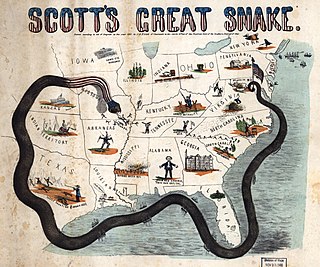
The Anaconda Plan is the name applied to a strategy outlined by the Union Army for suppressing the Confederacy at the beginning of the American Civil War. Proposed by Union General-in-Chief Winfield Scott, the plan emphasized a Union blockade of the Southern ports and called for an advance down the Mississippi River to cut the South in two. Because the blockade would be rather passive, it was widely derided by a vociferous faction of Union generals who wanted a more vigorous prosecution of the war and likened it to the coils of an anaconda suffocating its victim. The snake image caught on, giving the proposal its popular name.

USS Canonicus was a single-turret monitor built for the United States Navy during the American Civil War, the lead ship of her class. The ship spent most of her first year in service stationed up the James River, where she could support operations against Richmond and defend against a sortie by the Confederate ironclads of the James River Squadron. She engaged Confederate artillery batteries during the year and later participated in both attacks on Fort Fisher, defending the approaches to Wilmington, North Carolina, from December 1864 to January 1865.

Louis Malesherbes Goldsborough was a rear admiral in the United States Navy during the American Civil War. He held several sea commands during the Civil War, including that of the North Atlantic Blockading Squadron. He was also noted for contributions to nautical scientific research.
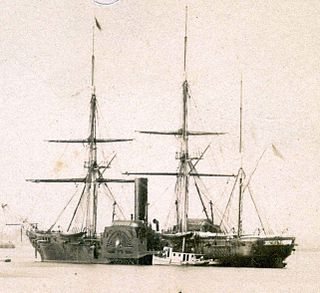
USS Susquehanna, a sidewheel steam frigate, was the first ship of the United States Navy to be named for the Susquehanna River, which rises in Lake Otsego in central New York and flows across Pennsylvania and the northeast corner of Maryland emptying into the Chesapeake Bay.

The Battle of Hatteras Inlet Batteries was the first combined operation of the Union Army and Navy in the American Civil War, resulting in Union domination of the strategically important North Carolina Sounds.

USS South Carolina (1860) was a steamer used by the Union Navy during the American Civil War.
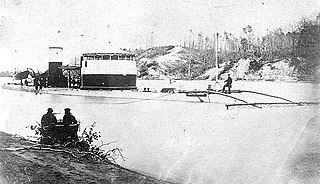
USS Saugus was a single-turreted Canonicus-class monitor built for the Union Navy during the American Civil War. The vessel was assigned to the James River Flotilla of the North Atlantic Blockading Squadron upon completion in April 1864. The ship spent most of her time stationed up the James River where she could support operations against Richmond and defend against a sortie by the Confederate ironclads of the James River Squadron. She engaged Confederate artillery batteries during the year and later participated in both attacks on Fort Fisher, defending the approaches to Wilmington, North Carolina, in December 1864–January 1865. Saugus returned to the James River after the capture of Fort Fisher and remained there until Richmond, Virginia was occupied in early April.

The Battle of Elizabeth City of the American Civil War was fought in the immediate aftermath of the Battle of Roanoke Island. It took place on 10 February 1862, on the Pasquotank River near Elizabeth City, North Carolina. The participants were vessels of the U.S. Navy's North Atlantic Blockading Squadron, opposed by vessels of the Confederate Navy's Mosquito Fleet; the latter were supported by a shore-based battery of four guns at Cobb's Point, near the southeastern border of the town. The battle was a part of the campaign in North Carolina that was led by Major General Ambrose E. Burnside and known as the Burnside Expedition. The result was a Union victory, with Elizabeth City and its nearby waters in their possession, and the Confederate fleet captured, sunk, or dispersed.

USS Mahopac (1864) was a Canonicus-class monitor built for the Union Navy during the American Civil War. The vessel was assigned to the James River Flotilla of the North Atlantic Blockading Squadron upon completion in September 1864. The ship spent most of her time stationed up the James River where she could support operations against Richmond and defend against sorties by the Confederate ironclads of the James River Squadron. She engaged Confederate artillery batteries during the year and later participated in both the first and second battles of Fort Fisher, defending the approaches to Wilmington, North Carolina, in December 1864 – January 1865. Mahopac returned to the James River after the capture of Fort Fisher and remained there until Richmond, Virginia was occupied in early April.

The Battle of Port Royal was one of the earliest amphibious operations of the American Civil War, in which a United States Navy fleet and United States Army expeditionary force captured Port Royal Sound, South Carolina, between Savannah, Georgia and Charleston, South Carolina, on November 7, 1861. The sound was guarded by two forts on opposite sides of the entrance, Fort Walker on Hilton Head Island to the south and Fort Beauregard on Phillip's Island to the north. A small force of four gunboats supported the forts, but did not materially affect the battle.
USS Whitehall was a steamer acquired by the Union Navy during the American Civil War. She was assigned blockade duty; however, her condition was not always considered seaworthy, and she was plagued with condition problems.
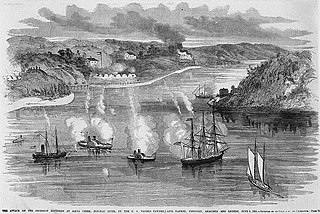
The Potomac Flotilla, or the Potomac Squadron was a unit of the United States Navy created in the early days of the American Civil War to secure Union communications in the Chesapeake Bay, the Potomac River and their tributaries, and to disrupt Confederate communications and shipping in the same.

USS Perry (1843) was a brig commissioned by the United States Navy prior to the American Civil War. She was tasked by the Navy for various missions, including those related to diplomatic tensions with Paraguay, the Mexican–American War, the slave trade, and the American Civil War. She was probably named after Commodore Oliver Hazard Perry.
USS Young Rover (1861) was a bark with an auxiliary steam engine acquired by the Union Navy during the American Civil War. She was used by the Union Navy as a gunboat in support of the Union Navy blockade of Confederate waterways.
USS George Mangham (1854) was a schooner acquired by the Union Navy during the American Civil War. She was used by the Union Navy as a gunboat in support of the Union Navy blockade of Confederate waterways.
The Blockade Strategy Board, also known as the Commission of Conference, or the Du Pont Board, was a strategy group created by the United States Navy Department at outset of the American Civil War to lay out a preliminary strategy for enforcing President Abraham Lincoln's April 19, 1861 Proclamation of Blockade Against Southern Ports. Enforcing this blockade would require the monitoring of 3,500 miles (5,633 km) of Atlantic and Gulf coastline held by the Confederate States of America, including 12 major ports, notably New Orleans and Mobile. The group, consisting of: Samuel Francis Du Pont, who acted as chairman; Charles Henry Davis; John Gross Barnard; and Alexander Dallas Bache, met in June to determine how best to cut off maritime transport to and from these seaports. Their reports for the Atlantic seaboard were used, with modifications, to direct the early course of the naval war. Their analysis of the Gulf Coast was not so successful, largely because the detailed oceanographic knowledge that marked the Atlantic reports was not available for the Gulf.
Burnside's North Carolina Expedition was a series of engagements fought along the North Carolina Coast between February and June 1862. The expedition was part of Winfield Scott's overall Anaconda Plan, which aimed at closing blockade-running ports inside the Outer Banks. The amphibious operation was carried out primarily by New England and North Carolina troops under Brig. Gen. Ambrose E. Burnside and assisted by the North Atlantic Blockading Squadron under Captain Louis M. Goldsborough.

Commodore John R. Goldsborough was an officer in the United States Navy. Goldsborough was made a cadet-midshipman in 1824 and as such saw action in the Mediterranean against pirates. In one incident, while in charge of 18 men he attacked and captured a Greek pirate ship with a 58-man crew.
